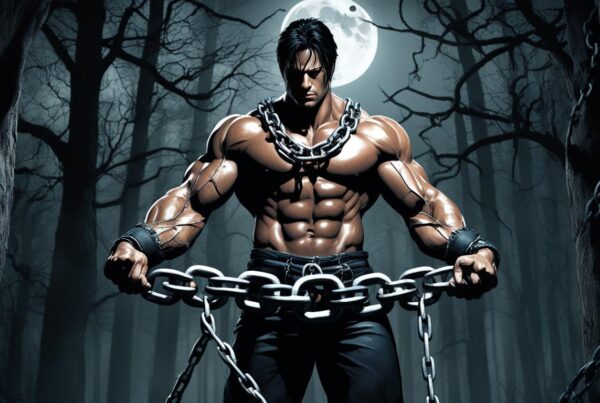Looking for an enthralling audiobook to indulge in? Look no further than the latest installment in the Left Behind series, “Desecration” by Tim LaHaye and Jerry B. Jenkins. In this audiobook review, we’ll explore the world of “Desecration,” examining its plot, characters, themes, and overall impact on readers.
Through analysis of the audiobook’s narration performance and production quality, we’ll provide a comprehensive evaluation of the listening experience. Additionally, we’ll discuss any controversies or criticisms surrounding “Desecration” and offer recommendations for readers interested in embarking on this thrilling journey. So sit back, relax, and prepare to be transported by “Desecration” – the ultimate Christian science fiction experience.
Overview of “Desecration”
“Desecration” is the ninth book in the Left Behind series written by Tim LaHaye and Jerry B. Jenkins. This installment follows the continuing struggles of the members of the Tribulation Force as they grapple with the aftermath of the Rapture and the rise of the Antichrist, Nicolae Carpathia. The story centers around the Tribulation Force’s efforts to thwart Carpathia’s plans and prevent the desecration of the temple in Jerusalem, which is a pivotal event in the end-times prophecies.
The main characters of the series, including Rayford Steele, Buck Williams, and Chloe Steele, all make an appearance in “Desecration” and are joined by several new characters who add depth and complexity to the story. The book explores several themes, including the battle between good and evil, faith, redemption, sacrifice, and the consequences of one’s actions in the face of adversity.
This installment is a critical point in the series and sets the stage for the events in the final books. “Desecration” builds upon the groundwork laid in the earlier books and raises the stakes, ramping up the tension and drama as the apocalypse draws closer.
Key Details
| Title | Desecration |
|---|---|
| Authors | Tim LaHaye and Jerry B. Jenkins |
| Series | Left Behind |
| Genre | Christian fiction, Apocalyptic Fiction |
| Published | 2001 |
| Pages | 416 |
| ISBN | 978-0842329281 |
Plot Analysis
“Desecration” by Tim LaHaye and Jerry B. Jenkins follows the ongoing battles between the forces of both good and evil in the left-behind world. In this section, we delve into the plot analysis of this captivating book. Throughout the story, twists and turns abound, creating suspense and intrigue for the reader.
| Major Plot Points | Contribution to Story Arc |
|---|---|
| Buck Williams finds himself torn between his family and his mission as an accomplished journalist. | Develops and explores the theme of sacrificing personal desires for the greater good. |
| Nicolae Carpathia is resurrected after his assassination, with supernatural powers rendering him invincible. | Raises the stakes for the continued conflict between the forces of good and evil. |
| The Millennial Kingdom is established, bringing about a thousand years of peace on Earth. | Resolves the central conflict of the series and sets the stage for the final showdown between the forces of good and evil in the last book of the series. |
The intricate plot of “Desecration” masterfully ties these and other plot points together, creating a compelling narrative that keeps the reader engaged from start to finish. The book’s focus on the struggle between good and evil makes the twists and turns all the more impactful and drives home the book’s central themes.
Character Development
In “Desecration,” Tim LaHaye and Jerry B. Jenkins expertly craft their characters to reflect their struggles and beliefs. The protagonist, Rayford Steele, shows remarkable growth in his perseverance and faith despite overwhelming odds. Additionally, Buck Williams, one of the most complex characters in the series, deals with his conflicting beliefs about religion and his duty as a journalist.
The authors do not shy away from portraying the flaws and challenges of their characters, making them relatable and human. Hattie Durham’s struggle to accept the truth about the Rapture and Carpathia’s true nature adds intrigue to the plot, while Chloe Steele’s unwavering loyalty to her beliefs and family ties the entire narrative together. Overall, the character arcs in “Desecration” are well-crafted and integral to the compelling story.
Writing Style
Tim LaHaye and Jerry B. Jenkins have a distinctive writing style that draws the reader in and keeps them engaged throughout “Desecration.” Their prose is fast-paced and action-packed, with well-placed moments of reflection and emotional depth.
The authors also do an excellent job of balancing the perspectives of multiple characters, providing readers with a well-rounded understanding of the story’s events and their impacts on those involved. Each chapter ends on a strong note, leaving the reader eager to find out what happens next.
LaHaye and Jenkins make great use of imagery and metaphors, creating vivid descriptions that bring the story’s settings and characters to life. Their dialogue is sharp and witty, adding an extra layer of enjoyment to the reading experience.
Overall, the writing style in “Desecration” is a testament to the skill of its authors and their ability to create an engaging and thrilling narrative.
Narration Performance
One of the key elements of any audiobook is the narration performance. In the case of “Desecration,” the audiobook version features skilled voice acting and careful attention to pacing and delivery. The narrator effectively captures the suspenseful tone of the book, keeping listeners engaged and invested in the story. Additionally, the choice of narrator complements the book’s themes and tone, creating a cohesive and immersive listening experience.
Throughout the audiobook, the narrator demonstrates a strong understanding of the characters and their motivations, delivering lines with appropriate emotion and nuance. The pacing is consistent and well-suited to the book’s plot, building suspense effectively and keeping listeners engaged. Overall, the narration performance in the audiobook version of “Desecration” is a notable strength, adding to the overall quality of the listening experience.
Audiobook Production Quality
When it comes to the audiobook version of “Desecration,” the production quality is certainly noteworthy. The narration is clear and expressive, making it easy to follow along with the story, and the audio levels are consistent throughout. In addition, the use of sound effects and music enhances the listening experience and adds depth to the overall production.
Listeners can expect a high-quality audiobook that captures the drama and suspense of the novel. The sound effects and music are expertly chosen, adding to the atmosphere and providing a more immersive experience for the listener.
Sound Effects
The sound effects in the audiobook version of “Desecration” are incredibly effective in bringing the story to life. From the sound of gunfire to the rumble of an earthquake, each effect is carefully chosen to add depth and dimension to the narration. Not only do these effects contribute to the overall production quality, but they also help to create a more immersive experience for the listener.

Music
The music in the audiobook version of “Desecration” is equally impressive. The score is expertly composed and adds emotional weight to the story, providing a suitable accompaniment to the action and dialogue. Whether it’s a soaring orchestral piece during a moment of triumph or a haunting melody during a moment of tragedy, the music in this production enhances the listener’s experience.
Themes Explored
Desecration delves into several central themes that are prominent throughout the book, resonating with readers and contributing to the overall message of the Left Behind series.
Good vs. Evil
One of the major themes in Desecration is the battle between good and evil. The book explores this theme through the actions and motivations of its characters, particularly as they respond to the unfolding events of what is commonly referred to as the End Times. The ongoing conflict between the forces of good and evil provides a compelling backdrop to the story, lending it an air of danger and urgency.
Faith and Spirituality
Another significant theme in Desecration is faith and spirituality. The book encourages readers to consider their own beliefs and to reflect on what it means to live a life of faith in the face of overwhelming adversity. Throughout the novel, key characters struggle with issues related to faith and spirituality, culminating in moments of great personal growth and understanding.
Redemption and Forgiveness
A third theme explored in Desecration is the possibility of redemption and forgiveness, even in the face of seemingly insurmountable odds. The book presents situations in which characters are forced to confront their own shortcomings and to struggle with the consequences of past mistakes. Through their experiences, readers are given the chance to reflect on the idea that it is never too late for redemption and that forgiveness, both of oneself and of others, is always possible.
Overall, the central themes explored in Desecration contribute to the deeper message of the Left Behind series, one that encourages readers to engage with questions of faith, morality, and spirituality in powerful and thought-provoking ways.
Reception and Impact
Since its publication in 2001, “Desecration” has received both positive and negative reviews from readers and critics alike. On online book review sites such as Goodreads and Amazon, the book has an average rating of 3.8 and 4.5 stars out of 5, respectively, based on thousands of user ratings.
Several reviewers praised the book’s fast-paced action, engaging plot, and vivid descriptions, highlighting the authors’ ability to keep readers on the edge of their seats. Many also commended the book’s exploration of religious themes and the battle between good and evil, describing it as thought-provoking and spiritually uplifting.
However, some readers criticized the book’s heavy-handed morality and religious overtones, which they felt overshadowed the characters and plot. A few reviewers also found the writing style to be simplistic and predictable, detracting from their overall enjoyment of the book.
Despite these mixed reviews, “Desecration” and the Left Behind series as a whole have had a significant impact on popular culture and society. The books have sold more than 65 million copies worldwide and have been translated into dozens of languages.
Additionally, the commercial success of the series has spawned several spin-off products, including movies, graphic novels, and video games. The book’s influence has also been felt within the religious community, with some churches and schools incorporating the series into their curricula.
Overall, “Desecration” has sparked widespread discussion and debate among readers and critics, leaving a lasting impression on popular culture.
Comparison to Previous Books in the Left Behind series
When comparing “Desecration” to earlier books in the Left Behind series, several notable differences can be observed. Firstly, the pacing of the story feels more urgent and fast-paced than in previous installments. The action sequences are more frequent and intense, keeping readers on the edge of their seats throughout the narrative.
Additionally, the character development in “Desecration” feels more nuanced and layered than in earlier books. Main characters experience significant growth and transformation, introducing deeper emotional complexity to the series.
The themes explored in “Desecration” are also slightly different from previous books. While the central focus remains on faith and spirituality in the face of an impending apocalypse, the book explores more complex moral themes such as betrayal and sacrifice.
Comparison Table
| Aspect | “Desecration” | Previous Books in the Series |
|---|---|---|
| Pacing | Fast-paced, urgent | Slower, more deliberate |
| Character Development | Nuanced, emotionally complex | Simpler, more archetypal |
| Themes | Exploration of complex moral themes such as betrayal and sacrifice | Focus on faith and spirituality in the face of the apocalypse |
Overall, “Desecration” stands out as a significant progression in the Left Behind series, building on the strengths of earlier books while introducing new complexities and challenges to the narrative.
Cultural and Historical Context
Understanding the cultural and historical context surrounding the creation of “Desecration” sheds light on how authors Tim LaHaye and Jerry B. Jenkins approached their narrative. The book was published in 2001, during a time of significant cultural changes in the United States. The country was still reeling from the aftermath of the 9/11 attacks, and religious tensions were high amidst the ongoing War on Terror.
Furthermore, “Desecration” was part of the larger “Left Behind” series, which had been ongoing since 1995. The series was a product of the Evangelical Christian publishing industry, which had experienced significant growth in the mid-1990s. LaHaye and Jenkins were part of a wave of Christian authors who sought to create fictional narratives exploring religious themes and end-times theology.
Thus, “Desecration” must be viewed within the context of the broader cultural and literary landscape of the late 1990s and early 2000s. The book speaks to the particular religious and cultural concerns of its time, and its narrative choices reflect the broader trends in Evangelical Christian fiction.
Criticisms and Controversies
Despite its popularity among readers, “Desecration” has not been without its share of criticisms and controversies.
One common concern raised by critics is the portrayal of non-Christian characters in the book, with some arguing that they are depicted in a negative light. Others have criticized the overall tone of the series, noting that it can come across as preachy or didactic.
Another controversy surrounding “Desecration” involves its treatment of prophesy and end-times theology. Some readers have taken issue with the book’s specific interpretations of these concepts, while others have criticized it for perpetuating harmful or divisive beliefs.
Despite these criticisms, “Desecration” continues to be a popular and influential book in the Christian fiction genre.
Criticisms and Controversies
| Criticism/Controversy | Description |
|---|---|
| Portrayal of non-Christian characters | Some critics argue that non-Christian characters in the book are portrayed in a negative light. |
| Preachiness | Some readers have criticized the series for its preachy or didactic tone. |
| End-times theology | Some readers have controversial interpretations of the book’s treatment of prophesy and end-times theology. |
| Harmful beliefs | Some critics have accused the book of perpetuating harmful or divisive beliefs. |
Recommendations
After a thorough analysis of the audiobook version of “Desecration” by Tim LaHaye and Jerry B. Jenkins, we highly recommend it to fans of Christian fiction and post-apocalyptic novels. The captivating plot, well-developed characters, and thought-provoking themes make it a must-read in the Left Behind series.
Furthermore, the narration performance by Richard Ferrone is exceptional and fully immerses the listener in the story. The production quality of the audiobook surpasses expectations, adding to the overall listening experience. Whether you are a fan of audiobooks or not, this adaptation of “Desecration” is one that cannot be missed.

For those who have not read the previous books in the series, we recommend starting from the beginning with “Left Behind” to fully understand and appreciate the world-building and character arcs. However, “Desecration” can also be enjoyed as a standalone novel.
Key Recommendations:
- Read or listen to “Desecration” by Tim LaHaye and Jerry B. Jenkins
- If choosing to listen, opt for the audiobook version narrated by Richard Ferrone
- Start from the beginning of the Left Behind series with “Left Behind” for a complete understanding of the story and characters
Conclusion
In conclusion, “Desecration” by Tim LaHaye and Jerry B. Jenkins is a gripping addition to the Left Behind series that will leave readers on the edge of their seats. The audiobook version is equally as captivating, with excellent narration performance and well-produced audio quality.
The plot is well-crafted, with several twists and turns that keep readers engaged. Furthermore, the character development in “Desecration” is impressive, with key characters experiencing significant growth and demonstrating strong motivations.
The writing style is engaging and maintains reader interest throughout the duration of the audiobook. The exploration of central themes such as faith, spirituality, and the battle between good and evil resonates well with readers.
Although “Desecration” has attracted some criticism and controversies in the past, it remains a popular and highly esteemed addition to the Left Behind series. The impact of the book is apparent in its positive reception and sustained popularity.
Overall, we highly recommend “Desecration” as an audiobook to anyone interested in the Left Behind series or looking for an engaging thriller. The book offers an intriguing plot, dynamic characters, and well-produced audio quality that is sure to entertain listeners.



